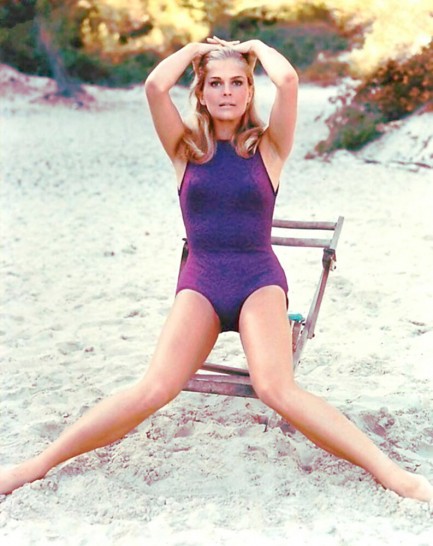 Don't hate the Playa, hate the games. 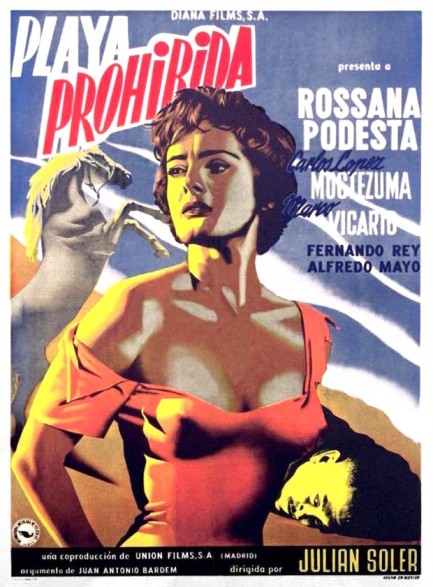 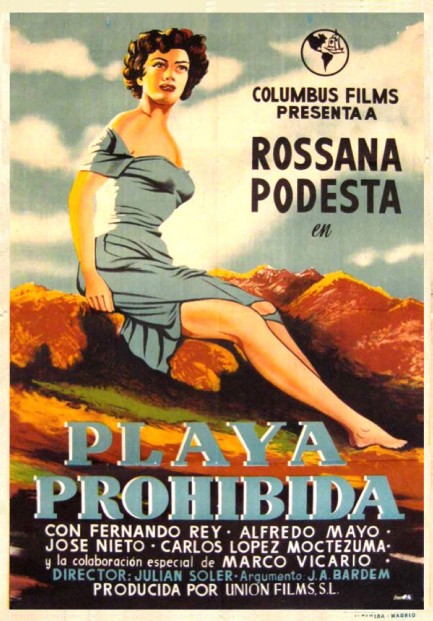
Playa prohibida was a Mexican-Spanish co-production filmed on Mallorca, starring Rossana Podesta, that premiered in Mexico today in 1956 and reached Spain the next year, in March 1957. Above are the Mexican and Spanish posters, both quite nice we think. They're differentiated by the fact that one gives second billing to Carlos López Moctezuma, who was Mexican, while the other gives second and third billing to Spanish actors Fernando Rey and Alfredo Mayo. Podesta plays a woman living in a beach town, and everyone thinks she's daft. When she's found on the beach standing over a corpse and looking guilty, the cops want to pin the crime on her, but a screenwriter passing through takes up the mystery and—with the help of his story construction skills—tries to figure out what happened. He narrates a significant part of the film, but other characters apply voiceover too, including the allegedly mad Podesta. The puzzle is eventually solved, and as you'd expect it's layered with jealousy, greed, betrayal, and all the usual games. If you're thinking this sounds a bit familiar, that may because the setting bears some resemblance to Podesta's 1953 Mexican made thiller La red, in which she was also a somewhat enigmatic woman living in a small seaside community. We suppose when Mexican filmmakers thought "exotic beach beauty" Podesta came to mind, and why not? Just look at her. Her presence alone makes Playa prohibida worth a viewing, at least for us. And possibly for you too. For the moment—i.e. while the link lasts—you can watch it on YouTube and decide for yourself. Spanish required. 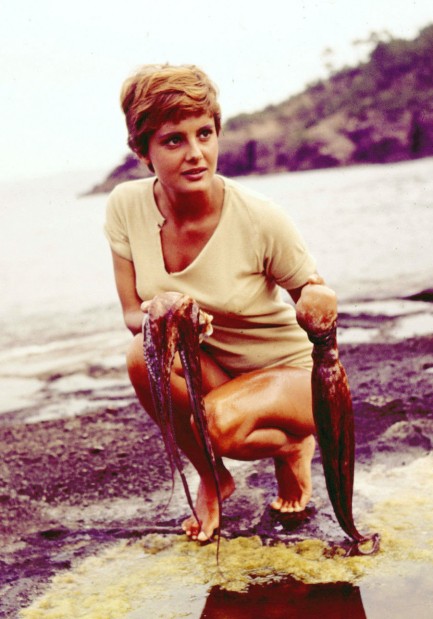
 Should she stay or go? The chair may be the factor that tips her one way or the other. 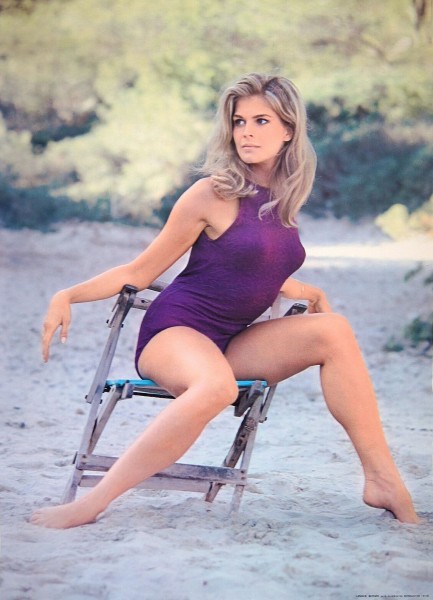 
This rare poster of U.S. actress Candice Bergen was printed and distributed in 1972 by a company called Nats Co-operated Reproduction. The shot was made in 1968 by famed photographer Terry O'Neill. There are other photos from the session. A couple even feature the same weathered beach chair that looks set to snap at any moment like something made from chopsticks, but as far as we know only Nats Co-operated used a color shot of Bergen in this particular pose. We've seen a black and white on Getty Images, but never one in color until this treasure. The beach, incidentally, immediately looked to us like our occasional stomping grounds the Balearic Islands, and sure enough, when we checked it turned out Bergen sat for this when she was filming The Magus in Mallorca. Another shot from the session appears below.
 Sun, sand, and an unusually high homicide rate.  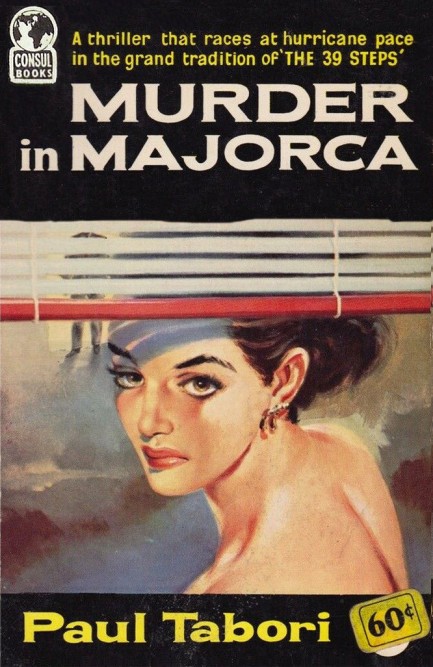
Of all the covers we've posted on Pulp Intl., these two—the first from U.S. publisher Dell, and the second from British publisher Consul—are among the most interesting. Both illustrate books called Murder in Majorca, both feature a female figure partly obscured by foreground blinds, and both have in the background the lower legs of a man walking into the room. But Michael Bryan and Paul Tabori are different authors, and these are different tales. Is that not weird as hell? We've always wanted to read these books because Majorca, aka Mallorca, is one of the great garden spots on Earth. We've been several times and it always recalibrates us perfectly. Also, there isn't much murder there, despite the titles of these books, which is a nice add-on to the sun, sand, food, bars, architecture and beautiful people.
Michael Bryan was in reality Brian Moore, and also wrote as Bernard Mara. His Murder in Majorca appeared in 1957. Paul Tabori was in reality Hungarian author Pál Tábori, and his Murder in Majorca came in 1961. How did these two uncredited covers get to be virtually identical? No idea. Sometimes when a book was reprinted overseas a second artist was commissioned to do a riff on the original cover, such as here. So maybe the second piece was for a re-issue, but it fell through, and the art was lying around when Tabori wrote his book. That's a wild-ass guess that has very little chance of being correct, but we just know these two fronts can't be similar by coincidence, so that's all we've got by way of explanation. Maybe you have a better deduction, or even the facts. If so, we'd love to know.
 Elizabeth Taylor has a stroll under the Spanish sun. 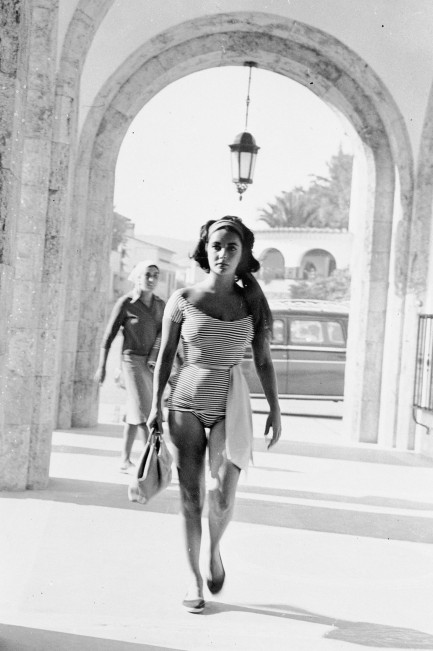
We just saw Liz Taylor a couple of weeks ago, but we're bringing her back because we liked this shot of her heading for the beach somewhere on the Costa Brava, Spain, during the production of her drama Suddenly Last Summer. We know Spain quite well, so we challenged ourselves to identify this exact location. Many sites say the photo was shot in S'Agaro, but we don't think so. There are no arches quite like this in that town, not even along the Cami de Ronda that runs along the coast. Part of the movie was also filmed in Mallorca, but we definitely can't think of anyplace on Mallorca that has old architecture of this size near a beach, so call us stumped for now. The shot was made today in 1959.
 Can you get the ship's doctor for me? I seem to be stuck this way. 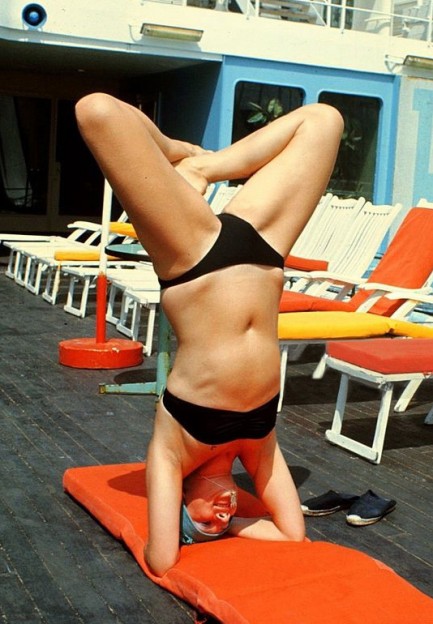
What is this yoga position called?
A: The Hidden Half Up. B: A Flying Lotus. C: The Gordian Knot. D: A French Twist
Actually, it's none of those, though we think flying lotus is probably closest. Let's just say Danish singer Gitte Haenning is performing a little yoga on the deck of a cruise ship steaming its way to Mallorca in this photo made in 1977. We've been to Mallorca a few times, and on none of those occasions did we bother to exercise, so good on Gitte. Haenning's last name was difficult to pronounce, which led to her becoming a one-name star—just Gitte—in both music and cinema. All in all, amazing accomplishments for someone who spent so much of her time as a soft pretzel.
 That was great. Send in the third mate when you go. And tell the fourth and fifth mates to get warmed up. 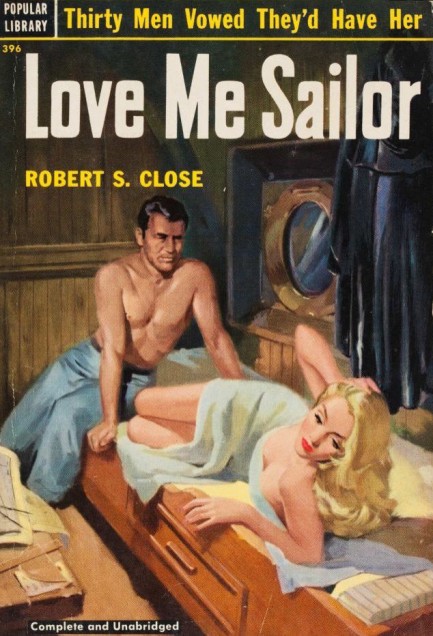
Love Me Sailor was originally published in 1945 by the Australian imprint Georgian House and what a bombshell it was. After much legal wrangling it was banned in 1948 and author Robert S. Close was tossed in prison. His sentence was three months but he served only ten days. He's the only Australian ever jailed for writing a book. After his release he left in disgust for France and didn't return for twenty-five years. Even then he stayed only briefly before leaving again and living the rest of his life on Mallorca. So what was the fuss about? Love Me Sailor tells the story of a male crewed windjammer that takes on a single female passenger in the form of Emma Miller. The men soon want to slide their dinghies into her cove but because she likes both sex and variety they're soon at each others' throats. Men, right? As a hurricane spins up, the question that arises is whether the crew can function well enough to survive. The book is a serious effort at literature and is highly regarded by many. The edition above from Popular Library appeared in 1952, and the cover art is by unknown.
 Okay, I’ll have one drink. Geez, you dead are pushy. 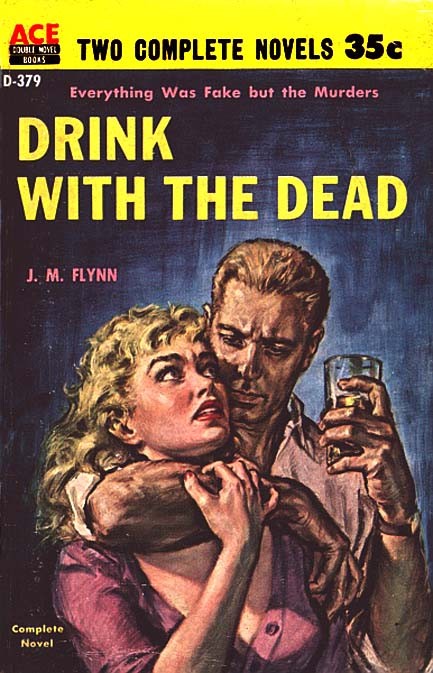 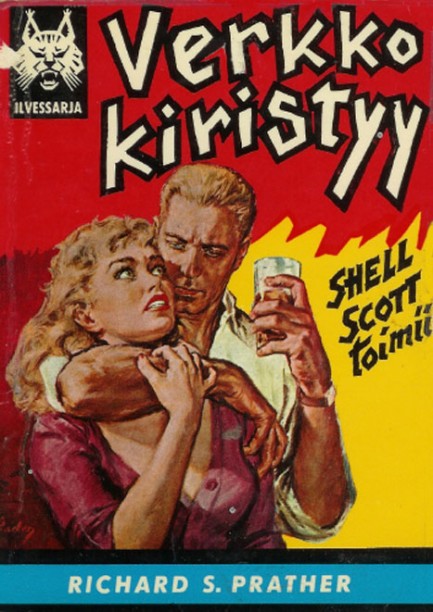
American author Jay Flynn, aka J.M. Flynn, is one of those writers whose real life reads as entertainingly as some of his fiction. He was a heavy drinker with a case of wanderlust, and he set up shop in places like Massachusetts, California, Paris, Mallorca, and Monte Carlo. 1959’s Drink with the Dead is considered one of his better books—you see Paul Rader's U.S. cover art above, and as a bonus we've shared Richard S. Prather's Finnish edition of Bodies in Bedlam, which borrows the same image. Drink with the Dead concerns a bunch of modern day bootleggers—ironic, considering Flynn got involved in the illegal liquor trade at one point. He was one of those rough and tumble writers that injected a lot of personal experience into his fiction, and whose erratic, hellraising ways always made subsistence a struggle. He spent time on skid row, was hired and fired by a lot of publishers, and refused to give up the booze even after his doctor said it would kill him. He died younger than he should have, perhaps, but left behind a lot of writing. You can find a detailed review of Drink with the Dead here. and a detailed bio of Flynn here.
|
 |

The headlines that mattered yesteryear.
2003—Hope Dies
Film legend Bob Hope dies of pneumonia two months after celebrating his 100th birthday. 1945—Churchill Given the Sack
In spite of admiring Winston Churchill as a great wartime leader, Britons elect
Clement Attlee the nation's new prime minister in a sweeping victory for the Labour Party over the Conservatives. 1952—Evita Peron Dies
Eva Duarte de Peron, aka Evita, wife of the president of the Argentine Republic, dies from cancer at age 33. Evita had brought the working classes into a position of political power never witnessed before, but was hated by the nation's powerful military class. She is lain to rest in Milan, Italy in a secret grave under a nun's name, but is eventually returned to Argentina for reburial beside her husband in 1974. 1943—Mussolini Calls It Quits
Italian dictator Benito Mussolini steps down as head of the armed forces and the government. It soon becomes clear that Il Duce did not relinquish power voluntarily, but was forced to resign after former Fascist colleagues turned against him. He is later installed by Germany as leader of the Italian Social Republic in the north of the country, but is killed by partisans in 1945.
|

|
|

It's easy. We have an uploader that makes it a snap. Use it to submit your art, text, header, and subhead. Your post can be funny, serious, or anything in between, as long as it's vintage pulp. You'll get a byline and experience the fleeting pride of free authorship. We'll edit your post for typos, but the rest is up to you. Click here to give us your best shot.

|
|






![]()
